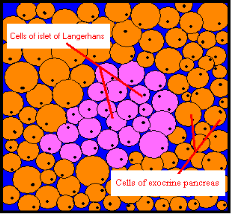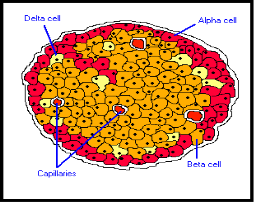Introduction
Diabetes mellitus is a serious endocrine disorder caused by a deficiency or diminished effectiveness of the hormone insulin and is categorized into two sub-categories, type 1 and type 2, together with the lesser known variant gestational diabetes (Burden, 2003, pp30-32). Type 1 diabetes is thought to be a genetically controlled autoimmune disorder that presents in childhood and is also know as juvenile onset diabetes or insulin dependent diabetes. Type 2 diabetes usually occurs in older, obese individuals; however, this type of diabetes is becoming increasingly more common among children and adolescents. Debatably, this is because of the increase in childhood obesity because of the sedentary lifestyle some children are adopting in today’s society. There is also an hereditary predisposition to type 2 diabetes. If one or both parents have type 2 diabetes the offspring is at an increased risk of getting the condition (Rosenbloom et al, 1999, pp345). It is important to note that gestational diabetes that is a complication of pregnancy is different from the pre-existing diabetes in pregnancy that will be discussed in this essay.
It is thought that approximately three to five percent of pregnancies are complicated by type 1 diabetes. During pregnancy diabetes mellitus can have a damaging detrimental affect on both maternal and foetal health. Conversely, diabetes is affected by the physiological changes that take place during pregnancy (Bewley, 2002, pp47-48).
This essay will examine the effects of type 1 diabetes on a seventeen year old (Carol) that is six weeks pregnant. The essay will start by investigating the prevalence of diabetes mellitus in order to acquire a global picture of the disease. The aetiology and physiology of type 1 diabetes will then be discussed. This essay will then go on to consider the signs and symptoms of the condition and its effects on Carol now and in the future. Next the complications of diabetes in general and during pregnancy will be discussed, considering the effects on Carol and her unborn child. The effects of type 1 diabetes on the developing embryo, foetus and mother will be addressed. Finally, the hereditary link for type 1 diabetes will be considered and the essay will then be concluded.
Epidemiology
Diabetes mellitus is a growing global and public health problem. The World Health Organisation (2006, p1) estimates that the problem could escalate to an estimated three hundred million people by 2025. It is thought that approximately one and a half million people in the United Kingdom have diabetes mellitus. Type 1 accounts for approximately twenty percent of cases of diabetes mellitus. Type 2 diabetes accounts for more than eighty percent of cases with more than one million people diagnosed in the United Kingdom (Burden, 2003, pp30-32).
The aetiology and physiology of type 1 diabetes mellitus
This section focuses on the causes of disease and the biological aspects of diabetes mellitus. As mentioned type 1 diabetes results from the complete absence of the hormone insulin that is involved in glucose metabolism. It is thought that it is an autoimmune disease in which the body’s immune system attacks and destroys the beta cells in the islets of Langerhans that are embedded in the tissues of the pancreas (See diagram 1).
Diagram 1, this shows the islets of Langerhans that are deeply embedded with the tissues of the exocrine pancreas (http://cal.man.ac.uk/student_projects/2000/mnby7lc2/pancreas.htm).
 Diagram 1
Diagram 1
The pancreas has two functions the exocrine cells produce digestive fluids and the endocrine cells produce hormones. It is the endocrine insulin producing beta cells that are important in the role of diabetes mellitus. The beta cells (see diagram 2) make insulin and when the body’s immune system attacks it results in the destruction of these cells. As the cells die insulin production stops and the consequences of this are impairment in function of, and damage to many of the organs in the body.
Diagram 2 shows the insulin producing beta cells that are found in the islets of Langerhans (http://cal.man.ac.uk/student_projects/2000/mnby7lc2/pancreas.htm).
 Diagram 2
Diagram 2
It is not known exactly what triggers this immune attack, but susceptibility to the disease might be inherited. The autoimmune attack may be triggered by reaction to a virus infection. The attack is thought to be carried out by the T cells of the immune system (Waugh and Grant, 2001, p234).
In Diabetes mellitus there is too much glucose in the blood. When carbohydrates are eaten they are broken down into glucose. This process is known as gluconeogenesis and occurs in the liver and kidneys. The level of glucose in the blood is regulated by the naturally occurring hormone insulin. Insulin promotes transport and entry of glucose into the body’s cell and tissues. Glucose is essential to the production of energy within the cells and without it cellular death will occur (Tortora and Grabowski, 2003, p627).
Signs and symptoms of type 1 diabetes mellitus
This section will examine the signs and symptoms that Carol would have exhibited before diagnosis and during the course of the condition. The initial clinical indication of untreated diabetes relates to elevated blood sugar levels, and loss of glucose in the urine. When there are excessive amounts of glucose in the urine, water is taken out of the body in large amounts by the process of osmosis (Waugh and Grant, 2001, p235). This results in polyuria (increased urine output) and that leads to dehydration. Dehydration causes polydipsia (increased thirst) leading to increased fluid consumption. The inability to utilise glucose energy eventually leads to weight loss despite excessive hunger (polyphagia). Dramatic weight loss would have been a clinical sign exhibited by Carol. Some patients also complain of fatigue, nausea and vomiting. Patients with diabetes are prone to developing infections of the bladder, skin, and vaginal areas; this is because hyperglycaemia can disrupt the action of phagocytes that are help to fight infection. The immune system in diabetes sufferers is suppressed and this limits the body’s ability to resist invasion by bacteria or viruses. Fluctuations in blood glucose levels can lead to blurred vision and extremely elevated glucose levels can lead to lethargy. Diabetic ketoacidosis is a serious medical condition resulting from uncontrolled diabetes. Ketoacidosis is caused by lack of insulin and occurs when the body uses fat as an energy source and ketones build up in the blood. Ketoacidosis starts slowly and builds up to a life-threatening condition that can result in coma and possible death (Burden, 2003, pp30-32).
Carol may have exhibited all or some of these symptoms when first diagnosed and she is exhibiting symptoms of weight loss, tiredness and mood changes at present. Debatably, this is because here blood glucose levels are uncontrolled due to her pregnancy. Having said this however, research has found that adolescents (in particularly girls) are not vigilant in all aspects of managing their condition. Having a certain level of hyperglycaemia will enable a person to eat, yet remain thin. In today’s society that is obsessed with thinness teenage girls might undertake such an action (Carson, 2000, pp36-37).
Complications of diabetes mellitus in general and during pregnancy
There are many long-term clinical complications of diabetes that affect various systems and organs of the body. Having diabetes mellitus increases the risk of developing irreversible microvascular or macrovascular disease. Microvascular diseases include retinopathy, nephropathy and neuropathy and macrovascular diseases include ischemic heart disease, stroke and peripheral vascular disease. These disease are all a result of poor glycaemic control (Donnelly et al., 2000, pp1062-1066). Diabetic retinal and renal disease will be discussed in more detail as pregnancy can result in further complications and poor pregnancy outcome.
Diabetic retinopathy is an eye disease that can lead to blindness. The longer a person is diabetic, the higher the chances are of developing the condition. It is thought that prolonged periods of hyperglycaemia cause damage to the blood vessels in the retina at the back of the eye. Diabetic retinal disease can deteriorate during pregnancy and poor glycaemic control in the first trimester is associated with the progression of retinopathy (Hill, 2004, p40-44, Donnelly et al, 2000, pp1062-1066). Carol should have her retinas examined at the start of her pregnancy to establish if she has pre-existing retinopathy. If retinopathy is diagnosed than Carol will need to have regular eye tests to monitor the condition. Continuous good glycaemic control will stop the condition from progressing.
Diabetic renal disease or nephropathy is again caused by hyperglycaemia resulting in damage to the capillaries in the kidneys. The kidneys are then unable to undertake filtration of amino acids and this leads to hypertensive disease. Women who have pre-existing nephropathy are at an increased risk of poorer pregnancy outcomes. This is because high blood pressure as a direct result of nephropathy can cause pre-eclampsia. This in turn can cause premature delivery and maternal death (Donnelly et al, 2000, pp1062-1066, Hill, 2004, pp40-44). It is important therefore, that Carol’s blood pressure is monitored throughout her pregnancy as hypertension is a sign of pre-eclampsia (Bewley, 2002, p50).
Effects of type 1 diabetes on the developing embryo, foetus and mother
It is suggested that type 1 diabetes mellitus in pregnancy puts the foetus and the developing baby at far greater risk than is imposed on the mother. Various, potentially damaging problems can arise from foetal reactions to maternal glucose levels. Therefore, if a mothers glucose levels are high, the foetus will have correspondingly high levels (Bewley, 2002, p51).
If a mothers blood glucose levels are continuously high (hyperglycaemia) during the first-trimester there is an increased risk of congenital anomalies such as neural tube defects that include spina bifida, abnormalities of the heart and anatomical abnormalities of the bones (Confidential Enquiry into Maternal and Child Health, CEMACH, 2005, p37). Neural tube defects are major birth defects of a baby’s brain or spine. They happen when the neural tube (that later turns into the brain and spine) does not develop in a correct anatomical manner resulting in damage to the brain or spine (Tortora and Grabowski, 2003, p1073). This happens within the first few weeks that a woman is pregnant, often before a woman knows that she is pregnant.
Another condition that is attributed to maternal diabetes is that of Polyhydramnios. This is the medical condition of too much amniotic fluid in the amniotic sac. Polyhydramnios is generally due to maternal diabetes and is thought to be caused by increased foetal urination. This is caused by the elevated amount of glucose in the mothers blood that cross the placenta and makes the blood of the foetus hyperglycaemic. This results in increased urine output from the foetus. In pregnancies affected by Polyhydramnios, approximately twenty percent of the neonates are born with a congenital anomaly of some type. There are a number of risks that are increased in polyhydramnios including cord prolapse, placental abruption and perinatal death (Pilu & Nicolaides, 2006)
Other adverse neonatal conditions that are attributed to maternal diabetes are neonatal mortality, premature birth, hypoglycaemia and an increased risk of respiratory distress syndrome (Bewley, 2002, p51). There is also an increased risk of macrosomia that can lead to an augmented possibility of shoulder dystocia and an assisted delivery. Macrosomia is related to maternal hyperglycaemia and is characterised by larger-than-normal birth weight in a newborn at over 4500 grams (10 pounds). High levels of glucose in the mother’s blood readily pass through the placenta to the developing baby stimulating insulin production in the baby. Insulin is a potent growth hormone and so fat is deposited which can result in a large baby. This can cause shoulder dystocia and birth trauma because the baby will not easily fit through the birth canal. Postpartum, the newborn continues to produce excessive quantities of insulin that can result in the infant being hypoglycaemic.The mother has an increased prevalence of pre-eclampsia, postpartum infection, postpartum bleeding, and caesarean section (Reece et al, 2004, p169) .
It appears from the research indicated that Carol needs to have optimum glucose control for her own health and for that of her baby. Women with type 1 diabetes should have a pre-conception glucose level within normal limits that is an HbA1c of below 7 percent. The management of pregnancies complicated by pre-existing diabetes mellitus should begin prior to conception (Reece et al, 2004, pp481). However, at seventeen it is quite possible that Carol’s pregnancy was unplanned.
Is type 1 diabetes mellitus hereditary?
It is thought that there may be a genetic or inherited susceptibility to diabetes. If a parent has type 1 diabetes, the chance that their children will be affected is about twenty-five to forty percent. In the instance of type 1 diabetes various genes have been indentifyed that might predispose an individual to the disease. Therefore, it is suggested that this genetic mutation might incline an individual to diabetes. It is debated that a genetic element is not, in itself enough to cause autoimmunity. It is suggested that external influences such as a viral infection are thought to trigger the disorder. It can be said that type 1 diabetes is an immunological disease that has a genetic background cause (Littorin, 2001, pp1033-37). It is possible therefore, that Carol has inherited a genetic susceptibility to type 1 diabetes from her mother, but environmental factors might activate the actual disease.
Conclusion
Diabetes is an increasingly common disease that if not controlled can cause a number of disabling lasting complications that can have a destructive influence on both quality and quantity of life. Type 1 diabetes is thought to be an autoimmune disease that leads to the complete destruction of the insulin producing beta cells in the pancreas. Insulin is needed to help glucose enter the cells of the body. Glucose is required in the cells to produce energy for normal cell function. It is possible that there is an hereditary link that predisposes an individual to the condition.
As Carol was diagnosed with type 1 diabetes mellitus at the age of seven and she has had difficulty in controlling her blood glucose levels, she is at an increased risk of developing diabetic complications. It appears that her pregnancy will also intensify the effects of some of the complications affecting both her own health and that of her baby. It is suggested that Carol needs to attain good glycaemic control for her own health and for the health of her baby.
Bibliography
Bewley C (2002) Diabetes in pregnancy. Nursing Standard, 16, 25, 47-52.
Burden M (2003) Diabetes: signs, symptoms and making a diagnosis. Nursing Times, 99, 1,
30-32.
Carson C (2000) Managing adolescents with type 1 diabetes. Nursing Times, 96, 45, 36-37
Confidential Enquiry into Maternal and Child Health: Pregnancy in Women with Type 1and Type 2 diabetes in 2002-03, England, Wales and Northern Ireland. London: CEMACH; 2005.
Diagram 1 and Diagram 2 http://cal.man.ac.uk/student_projects/2000/mnby7lc2/pancreas.htm, date accessed 23/11/2006.
Donnelly R, Emslie-Smith AM, Gardner ID and Morris AD (2000) Vascular complications of diabetes. British Medical Journal, 320, 1062-1066.
Hill J (2004) Identifying and managing the complications of diabetes. Nursing Times, 100, 34, 40-44.
Littorin B (2001) Family Characteristics and Life Events Before the Onset of Autoimmune Type 1 Diabetes in Young Adults: A nationwide study. Diabetes Care, 24, 1033-1037.
Pilu G and Nicolaides KH (2006) The 18-23 week scan: Polyhydramnios. http://www.fetalmedicine.com/18-23scanbook/Chapter14/chap14-03.htm, date accessed 23/11/2006.
Reece EA, Coustan DR and Gabbe SG (2004) Diabetes in Women: Adolescence, Pregnancy and Menopause. 3rd edition, Philadelphia, Lippincott Williams and Wilkins.
Rosenbloom AL, Young RS, Joe JR and Winter WE (1999) Emerging Epidemic of Type 2 Diabetes in Youth. Diabetes Care, 22, (2), 345-354.
Tortora GJ and Grabowski SR (2003) Principles of Anatomy and Physiology. 10th edition, New Jersey, John Wiley & Sons, Inc.
Waugh A and Grant A (2001) Ross and Wilson Anatomy and Physiology in Health and Illness. 9th edition, London, Churchill Livingstone.
World Health Organisation (2006) Diabetes. Fact sheet N°312, September 2006, http://www.who.int/mediacentre/factsheets/fs312/en/ date accessed 23/11/2006.
Cite This Work
To export a reference to this article please select a referencing style below:
Related Content
All TagsContent relating to: "chronic illness"
Chronic illnesses are non-communicable diseases which develop gradually over time. They generally cannot be solved instinctively and are barely to be cured ultimately. In most cases, chronic illnesses are more likely to be insidious where the patients have mild or no symptoms.
Related Articles


